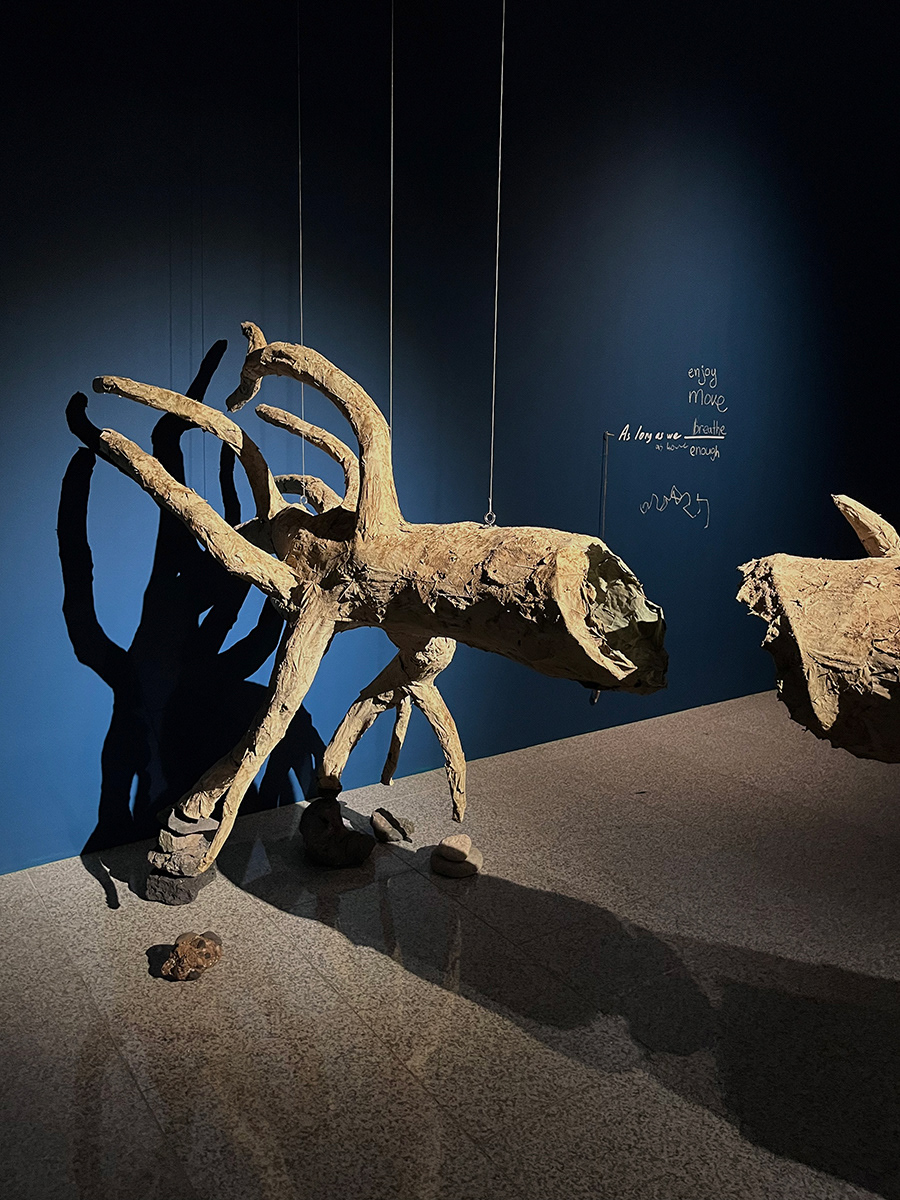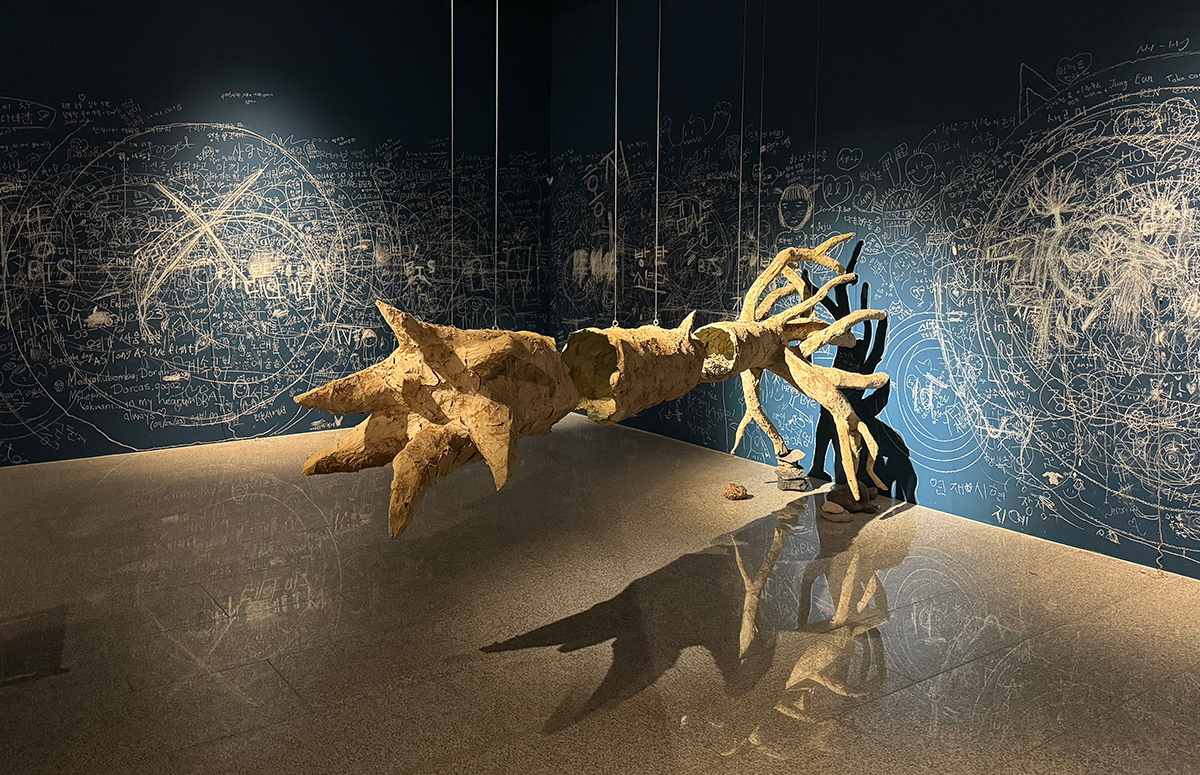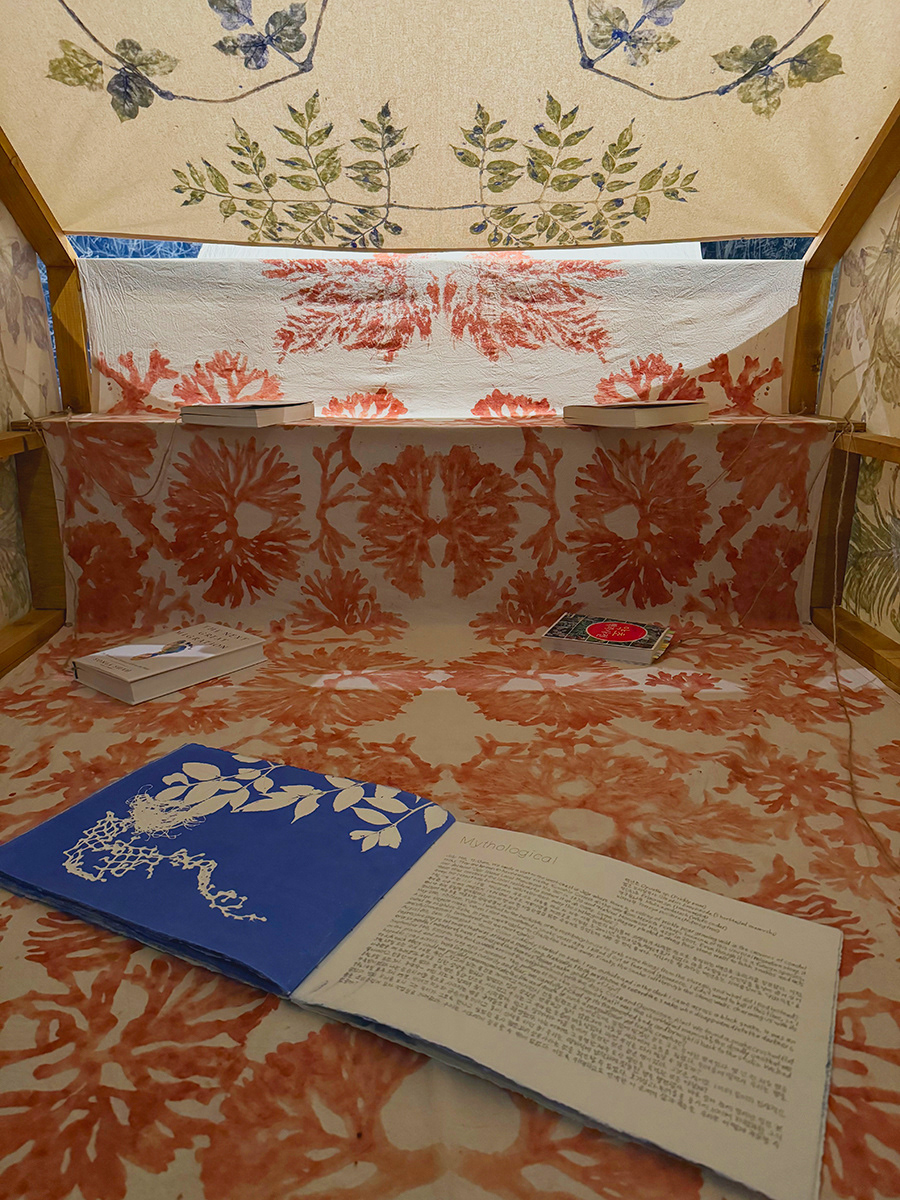HOMO MIGRATIO
Exhibition Title: Migrating Humans : Homo migratio
Date: Sep. 19 - Nov. 26, 2023
Venue: Jeju Museum of Art, Jeju Island, South Korea
Presented work: As Long As We _______
Collaboration between Yujin Lee and Ruangsak Anuwatwimon
3 Public Programs: Oct. 21, 3-5pm; Nov. 4, 2-4pm; Nov. 26, 2-4pm
전시 제목 : 이주하는 인간 : 호모 미그라티오
전시 기간 : 2023.09.19 - 11.26
장소 : 제주도립미술관
참여 작품 : 우리가 ______하는 한
이유진 x 루앙삭 아누왓위몬 협업 신작
전시 연계 프로그램 3회 : 10월 21일, 3-5pm; 11월 4일, 2-4pm; 11월 26일, 2-4pm
As long as we _____ is an immersive art installation that visualizes ecological and relational research conducted in collaboration between Yujin Lee and Ruangsak Anuwatwimon over the course of a two-month-long artist residency in Jeju. As long as we _____ invites the visitors to actively engage with the work, to imagine multiple scenarios and landscapes by filling in the blank with various nouns and verbs such as love, care, stay, leave, argue, sing, etc.
Mythology has been a collective and fluid knowledge system that mediated human interaction with the world. Non-human beings appeared in myths and rituals to represent our fears, joys, living and dying. The myth of Tosan snake goddess in Jeju symbolizes reincarnation and regeneration, depicting an outsider entering the island and forming entwining new relationships. Today, however, we rely on science to analyze the past and predict the future. Humans separate ourselves from the natural world and categorize non-human species as “invasive” or “endangered”. Ironically, some invasive species like the cactus of Wollyeong village are embraced and protected, while other endangered species like the dung beetle of Bijarim road are tragically ignored. Medicinal indigenous species like the arrowroot that had many beneficial uses are now considered invasive in Jeju and are facing extermination by the local government. The truth is, humans try to govern the natural world when we can’t even control ourselves. As long as we ____ unmasks the paradoxical and incomplete system of knowledge based on science, and redirects our imagination towards a mode of symbiosis, where we can collaborate on creating “a heterogeneous livable future landscape” despite the continuing human and non-human disturbances.
<우리가 _____하는 한>은 이유진과 루앙삭 아누왓위몬이 제주에서 두 달간 함께 거주하며 진행한 생태적이고 관계 중심적인 연구를 시각화한 몰입형 설치 작품이다. 관객은 작품 제목의 빈칸에 ‘사랑, 돌보는, 머무는, 떠나는, 논쟁하는, 노래하는’ 등 다양한 명사와 동사를 채워가며 복수의 시나리오 혹은 풍경을 상상하고 보다 적극적으로 작품과 관계 맺을 수 있다.
신화(神話)란 공동체를 바탕으로 한 가변적인 지식 체계로 인간이 세상과 맺는 관계를 받아들이는 매개체였다. 신화와 의식에 등장하는 비인간 존재는 우리의 두려움, 기쁨, 삶과 죽음을 상징했다. 환생과 부활을 나타내는 제주 토산리 뱀 신화는 외지인이 섬에 들어오면서 새로이 맺고 뒤엉키는 인연에 대한 이야기다. 그러나 오늘날 우리는 과학을 통해 과거를 분석하고 미래를 예측한다. 인간은 스스로를 자연 세계와 분리하고 비인간 종을 ‘침입종’ 혹은 ‘멸종위기종’으로 분류한다. 아이러니하게도 월령마을의 손바닥선인장 같은 특정 침입종은 보호 및 포용하는 반면, 비자림로의 애기뿔소똥구리와 같은 멸종위기종은 처참히 외면한다. 또한, 칡과 같이 약용 등 여러 쓰임을 가졌던 토착종은 이제 제주에서 침입종으로 간주하며 지방 정부의 ‘전쟁 선포’까지 받고 있다. 인간은 자연 세계를 지배하려 하지만 정작 스스로는 통제하지 못하고 있다. <우리가 ____하는 한>은 역설적이고 불완전한 과학 지식 체계의 가면을 내려놓고, 인간과 비인간의 지속적인 교란 행위에도 불구하고 ‘다차원적인 삶이 가능한(livable) 미래 풍경’을 함께 만들어 나가기 위한 공생적 태도를 함께 상상해 보고자 한다.










Text from the image above (위 이미지 작품 속 글):
Mythological
백년초 Opuntia sp. (Prickly pear)
짧은꼬리살무사 Gloydius brevicauda (Short-tailed mamushi)
망(국)초 Erigeron sp. (Horseweed)
멀구슬나무 Melia azedarach (White cedar)
비자나무 Torreya nucifera (Nutmeg tree)
July 11th, 11:15am. We made a visit to the west coast of Jeju where there is a colony of prickly pear growing wild in the crevices of coastal rocks. They are known to have arrived via the Kuroshio Current all the way from Mexico. Perhaps because of this unusual migration story, it was declared “Jeju Island Local Monument No. 35” in 1976 and “Natural Monument No. 429” in 2001. Even though it is a foreign species, these titles convinced the local residents to protect it at all costs. Some villagers planted it along their stone walls to fetch snakes and rats away. We cannot help but wonder, will it also fetch away the snake goddess?
May 25th, 10:06am. Yujin – I walked to the backside of the residency house to grab some things from the storage, and what did I find instead? A large elegant snake. When I first encountered a snake years ago, I killed it out of fear and ignorance. I didn’t want to kill it this time, so I called my neighbor, Seha. In fear, we struggled to chase the snake away. Finally, the snake left through the stone walls, charming us with its graceful movement. I wondered, will we meet again?
August 8th, 3am. Ruangsak – Young Ccino suddenly started to bark. I ran outside and in the dark I came across a black snake. It was an impressive steppe rat snake that was at least a meter long. Naturally, I took my phone to record the snake who disappeared into the darkness, ever so gently. I wondered, have I witnessed the famous Tosan snake goddess of Jeju?
September 14th, 5:05pm. We took a walk around the neighborhood with the dogs, Ccino and Geumsoon. Alas! We found a snake crushed flat on the ground, and not too long ago, it seemed. The pattern of the skin confirmed that it was the short-tailed mamushi, the deadly one that we hoped to come across. With lingering curiosity and fear, we carefully picked up its fragmented body and brought it back to the studio. We had to ask each other, could we possibly commemorate the life and death of such a magnificent yet fragile creature?
7월 11일 오전 11시 15분. 멕시코에서 쿠로시오 해류를 타고 와 제주 서쪽 해안의 바위틈에 자생하기 시작한 것으로 추정하는 백년초 군락지를 방문했다. 이런 특이한 이주 이야기 때문인지 1976년에 제주도 지방기념물 제35호로 지정된 후 2001년 천연기념물 제429호가 되었다. 마을 사람들이 선인장을 돌담에 옮겨 심어 뱀이나 쥐의 침입을 방지했다고 하기에 몇 해 전 미술관옆집 닭장 주위에도 심었는데 아주 잘 번식 중이다. 어디서든 잘 자라는 백년초는 외래종임에도 “귀화식물"로 정의되며 제주도를 대표하는 관광상품이 되었다.
5월 25일 오전 10시 06분. 유진 - 창고에 있는 물건을 꺼내려고 레지던시 건물 뒷편으로 걸어갔는데, 뜻밖에 발견한 것은 크고 우아한 뱀이었다. 몇 년 전 처음 뱀을 마주했을 때 두려움과 무지로 인한 살생을 범하고 말았다. 당시 상황을 반복하고 싶지 않았기에 이웃집 세하에게 도움을 청했다. 두려움에 떨면서 우리는 뱀을 쫓아내려고 한동안 애를 썼다. 결국 뱀은 돌담 안으로 사라졌고 우리는 그 우아한 모습에 매료당했다. 과연 우리는 다시 만날 수 있을까?
8월 8일 오전 3시. 루앙삭 – 어린 치노가 갑자기 짖기 시작했다. 밖으로 달려나가 어둠 속에서 발견한 것은 검은 뱀이었다. 그것은 적어도 1미터 길이의 인상적인 누룩뱀이었다. 나는 순순히 어둠 속으로 사라지는 뱀을 휴대폰으로 촬영했다. 나는 어쩌면 그 유명한 제주 토산 뱀신을 목격한 것은 아닐까?
9월 14일 오후 5시 05분. 반려견 치노와 금순이를 데리고 동네 산책을 하던 중! 우리는 땅바닥에 납작하게 짓눌린 뱀을 발견했다. 바로 얼마 전에 일어난 일인 것 같았다. 뱀피 무늬를 보니 그는 우리가 그토록 만나고 싶었던 독사 짧은꼬리살무사라는 것을 확인할 수 있었다. 호기심과 두려움을 동시에 느끼며 파편화된 그의 몸을 조심스럽게 모아 작업실로 가져왔다. 우리는 서로에게 질문할 수 밖에 없었다. 이토록 위대하고도 연약한 이 존재의 삶과 죽음을 우리는 어떻게 추모할 수 있을까?








Poem from the above image:
Protect them! Kick them out!
The feral cats / crested murrelet!
’Tis the cry of the ecociders disguised as heroes!
Expel them! Keep them safe!
The feral cats / crested murrelet!
Endangered Wildlife, Natural Monument, Legally Protected
are but hollow name tags.
Will Marado’s crested murrelets return,
As long as the feral cats are thrown out?
Will Bijarim Road’s fairy pitta return,
As long as the road construction continues after their breeding season?
’Tis the “meowing with your eyes closed”!
The main causes of extinction are:
Habitat loss, reckless hunting,
Pollution, disease, climate change…
Alas! Humans are to blame!
The site of the prickly pears
Who presumably migrated on the Kuroshio Current
Is declared a "Natural Monument"
For its value as a tourist attraction,
While the endangered dung beetles
Who resides along the Bijarim Road
Have faced a forced migration...
Protect them! Kick them out!
The feral cats / crested murrelet!
Is it not the cry of the ecociders disguised as heroes!
위 이미지 작품 속 시:
지키자! 쫓아내자!
길고양이, 뿔쇠오리!
영웅으로 둔갑한 생태학살 주범의 외침이다!
쫓아내자! 지키자!
길고양이, 뿔쇠오리!
멸종위기 야생생물, 천연기념물, 법정 보호종 같은 빈껍데기 명패.
길고양이만 쫓아내면 살아남을까? 마라도의 뿔쇠오리
번식기만 피한 공사강행으로 돌아올까? 비자림로의 팔색조
이것이야말로 눈감고 야옹이구나!
멸종의 주요 원인:
서식지 감소, 남획, 오염, 질병, 기후변화…
아! 이 모든 것이 인간의 짓거리였네!
쿠로시오 해류타고 왔다는 백년초의 “자생지”는
지역 관광상품 되어 천연기념물 지정하고
멸종위기 야생생물 애기뿔소똥구리는
비자림로에서 강제 이주 당했구나!
지키자! 쫓아내자!
길고양이, 뿔쇠오리!
이것이야말로 영웅으로 둔갑한 생태학살 주범의 외침이 아닌가!